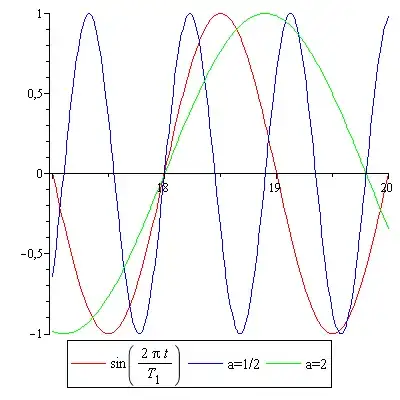A simple pendulum (whose length is less than that of a second's pendulum) and a second's pendulum start swinging in phase. They again swing in phase after an interval of $18$ seconds from the start. The period of the simple pendulum is
(A) $0.9$ sec
(B) $1.8$ sec
(C) $2.7$ sec
(D) $3.6$ sec
I was given a formula for such questions:
$$T = \frac {T_1 T_2} {T_1-T_2} \qquad (T_1>T_2)$$
where $T_1$ and $T_2$ are the time periods of the individual pendulums, and $T$ is the time after which they are in phase again.
I took $T_1$ as the seconds pendulum, i.e., $T_1=2$ seconds.
Using the formula, I got $T_2=1.8$ sec, which makes sense; the timestamps for each oscillation are:
$$1.8\ \ 3.6\ \ 5.4\ \ 7.2\ \ 9.0\ \ 10.8\ \ 12.6\ \ 14.4\ \ 16.8\ \ 18.0$$
seconds for simple pendulum, and $2, 4, 6, 8, 10, 12, 14, 16, 18$ seconds for seconds pendulum. None of these overlap, so if $T_2=1.8$, the pendulums swing in phase after intervals of $18$ seconds.
However, I also tried option A, and got the timestamps as:
$$0.9\ \ 1.8\ \ 2.7\ \ 3.6\ \ 4.5\ \ 5.4\ \ 6.3\ \ 7.2\ \ 8.1\ \ 9.0\ \ 9.9\ \ 10.8\ \ 11.7\ \ 12.6\ \ 13.5\ \ 14.4\ \ 15.3\ \ 16.2\ \ 17.1\ \ 18$$
seconds for simple pendulum, and $2, 4, 6, 10, 12, 14, 16, 18$ seconds for seconds pendulum. Again, none of these overlap, so if $T_2=0.9$ seconds also, the pendulums swing in phase after intervals of $18$ seconds.
According to the answer key, the answer is only B. Is A also correct, or am I missing something?
